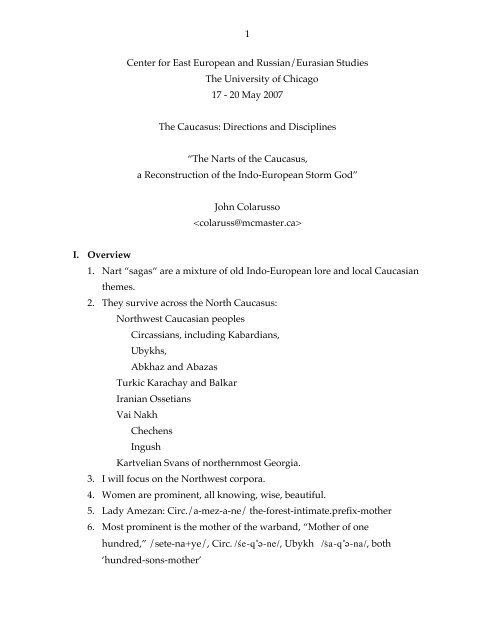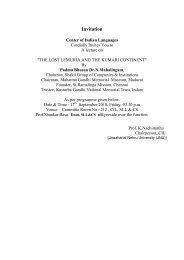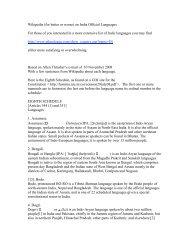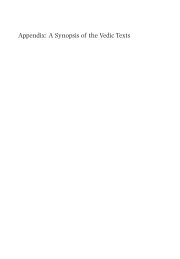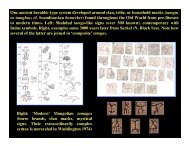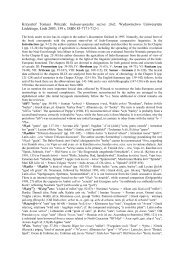1 Center for East European and Russian/Eurasian Studies The ...
1 Center for East European and Russian/Eurasian Studies The ...
1 Center for East European and Russian/Eurasian Studies The ...
- No tags were found...
Create successful ePaper yourself
Turn your PDF publications into a flip-book with our unique Google optimized e-Paper software.
1<strong>Center</strong> <strong>for</strong> <strong>East</strong> <strong>European</strong> <strong>and</strong> <strong>Russian</strong>/<strong>Eurasian</strong> <strong>Studies</strong><strong>The</strong> University of Chicago17 - 20 May 2007<strong>The</strong> Caucasus: Directions <strong>and</strong> Disciplines“<strong>The</strong> Narts of the Caucasus,a Reconstruction of the Indo-<strong>European</strong> Storm God”John ColarussoI. Overview1. Nart “sagas“ are a mixture of old Indo-<strong>European</strong> lore <strong>and</strong> local Caucasianthemes.2. <strong>The</strong>y survive across the North Caucasus:Northwest Caucasian peoplesCircassians, including Kabardians,Ubykhs,Abkhaz <strong>and</strong> AbazasTurkic Karachay <strong>and</strong> BalkarIranian OssetiansVai NakhChechensIngushKartvelian Svans of northernmost Georgia.3. I will focus on the Northwest corpora.4. Women are prominent, all knowing, wise, beautiful.5. Lady Amezan: Circ./a-mez-a-ne/ the-<strong>for</strong>est-intimate.prefix-mother6. Most prominent is the mother of the warb<strong>and</strong>, “Mother of onehundred,” /sete-na+ye/, Circ. /s!é-qWe-né/, Ubykh /s$a-qWe-na/, both‘hundred-sons-mother’
3on marginal IE, at end).(Both names must come from a Khotanese or Saka-like <strong>for</strong>m of Iranian,with *Cw- ≥ Co-, instead of the usual *Cw- ≥ Cp-.)3. Sosruquo from a rock (Storm God)4. sired by Sos (≤ IE *kJwés- ‘breath’, Skr s@vas-, Eng wheeze) or Gorgonizh5. Sosruquo has voice like thunder6. Totrash is a darkness with eyes that gleam like the Morning <strong>and</strong> EveningStars; they are compared to Sirius in brightness.(Abaza variant:s-na-ps@e%-yd-ta = ye-HWa-d sawsre%q&WaI-thither-look-past-as = he-say-past Sosruquoye%-la-kWa a-yac@&Wa% a%-ps@-tahis-eye-plural the-star its-look-asye-k&az+k&az-e%ydthey-sjine+shine-dynamic.presenta-s@e%-yac@&Wa y-\a-y-wa% a+wa%-ythe-white-star they-change.of.state-grow-present.participle that+distal<strong>and</strong>a-Oa%-ra la% tab ye%-la-kWa = ye-HWa-dit-so.much-adv dog pan his-eye-pl = he-say-past).7. First duel:a. Totrash makes Sosruquo plow the sky like a woolen ball (cloud?)b. T makes S plow the earth with his shoulder like a team of oxen.c. T makes S vomit up all the mother’s milk that he had ever drunk= loss of kinship ties, since mother’s milk is symbolic of kinshipd. T dirties S’s moustache, <strong>and</strong> S snots like eight oxen = an old mouthwound, emasculation8. Sosruquo begs <strong>for</strong> mercy.9. Totrash grants him a reprieve.10. <strong>The</strong>y agree to meet on Harama Hill.11. Second duel:a. She says that Totrash was one of 9 brothers.
4b. <strong>The</strong> other eight are already dead.c. Totrash must “follow their path.”d. Wise mother Setenaya advises Sosruquo to put bells on his horse.e. <strong>The</strong> bells will frighten Totrash’s horse.f. Sosruquo reaches Harama Hill be<strong>for</strong>e Totrash.g. Sosruquo creates a fogh. When Totrash arrives Sosruquo makes his horse ring the bells.i. Totrash’s horse rears up.j. Totrash rips out its jaws trying to rein it in (shifted version of Indra’swound)k. Sosruquo strikes at him from the fog.l. Sosruquo calls Totrash a piglet (late Muslim slur?).m. When Totrash begs <strong>for</strong> mercy Sosruquo says they could go on <strong>for</strong>everthis wayn. He cuts off Totrash’s heado. He brings it to Setenaya.p. Setenaya flies into a fury <strong>and</strong> dem<strong>and</strong>s that he take it away toTotrash’s mother.q. He brings it to Totrash’s mother.r. She calls him ‘a dog’ <strong>and</strong> throws a spit/knitting needle at him.s. It wounds him in the leg.t. He is called Lame Sosruquo hence<strong>for</strong>th.IV.Comparison:1. Storm godNWC: To-trash is a darkness,Sosruquo has a voice of thunder.Sosruquo is a shape changer, <strong>and</strong> strikes his enemies as a fog.Sosruquo is a degraded storm god.Hittite: Zaskhapuna (Hattic name) is the storm god.(*)Tarhunnash, ‘Conqueror,’ is the storm god(Fortson, p. 26; Watkins p. 316; this is a reconstructed name).Hurrian: Teshub is the storm god.
5Irel<strong>and</strong>:<strong>Russian</strong>:Cú Chulainn exhibits bizarre battle ‘tremors.”(He changes shape.)He has a deafening, terrifying battle cry.Volkh Vseslavjevich changes shape.He also has a voice of thunder.2. Stony wombNWC: Sosruquo is born aflame from a rock.Hitt: --Hurr: Ubelluri, a substrate from which heaven <strong>and</strong> earth arise, bears achthonic monster, Ullikumi(ulli-kumi striker-(of.)kumi, where Teshub lives;<strong>for</strong> Ubell-ur cf., Gk omphalos, Eng. navel – Gilles Gauthier, p.c.)3. Born aflame, heroic heatNWC: Sosruquo is born aflameHitt: --Hurr: --India: tapasIranian: Ossetian Batradz turns red hot as he dances upon his pyre.Russiam: Ilja Murometz sits on a stove <strong>for</strong> 33 years so that he can per<strong>for</strong>mheroic deeds.Irel<strong>and</strong>: Lug turns red hot with rage when he accuses the sons of Turanof killing his father, Cian.Cú Chulainn must be dunked in three vats of water to cool himof his battle frenzy when he returns from his first exploits.Greece: <strong>The</strong>tis tries to roast the mortality out of her demi-god son,Achilles.Demeter tries to roast the mortality out of Demophoön.Norse: Thor has a fiery red beard.Baltic: Lith. Pérku–%nas, Latv. P é–rko–ns has a fiery red face,
64. God of the <strong>for</strong>ge, the Great SmithNWC: Satanaya, Sosruquo’s mother, is assisted in her delivery byTlepsh, the god of the <strong>for</strong>ge.Aynar is the god of the <strong>for</strong>ge in Abkhazian( /a-yn-ar/ the-great-gerund, ‘the great one’)Sosruquo is rendered lame by Totrash’s mother, who isoutraged at the death of her son.Smiths are usually lame, so this links Sosruquo with the smithy.Hitt: --Hurr: --Irel<strong>and</strong>: Cú Chulainn is linked with the <strong>for</strong>ge through Culann.Finn <strong>and</strong> his Fiana encounter a young man who is a one-eyedsmith (Gregory, 255-6).Greece: <strong>The</strong> three original Cyclopes <strong>for</strong>ge Zeus’s thunderbolts.5. Quenching <strong>and</strong> temperingNWC: Sosruquo is said to be hardened everywhere but his thighs,where the Smith held him with tongs.Sosruquo is called ‘dark,’ Circ. /s!&Wec&/ , like hardened steel.Sasruquo says that he is steel, steel alloy (Colarusso 2002: 520-1),Abazaa-Z@e%r s-s@Ja-ø-p&,the-steel-my-blood-be-present.stative,Z@e%r-ta s-a+l+a+r+c@Wa-ø-p&steel-adv I-it+into+it-cause-flow-be-pres.stat (‘steel alloy’).Hitt: --Hurr: --Greece: Achilles’ heelNorse: Sigurd, Saga of the Volsungs (Siegfried in the Nibelungenlied)baths in hot dragon’s blood (Fafnir’s) to obtain a toughened(steely) skin.Sigurd is vulnerable only where a leaf l<strong>and</strong>ed on his back <strong>and</strong>
7obstructed the dragon’s blood.6. Mother of the warb<strong>and</strong>NWC: Satanaya is “mother of one hundred,” “mother of all the Narts.”(<strong>for</strong> Circassian <strong>and</strong> Ubykh <strong>for</strong>ms, see §I.6, above)Hitt: --Hurr: Hepa/Hebat (wife of Teshub) is the ‘Allmother’Irel<strong>and</strong>: Queen Madb honors all the heroes, the three warb<strong>and</strong>s (ofLeoghaire, Conall, <strong>and</strong>f Cú Chulainn).<strong>The</strong> three Madbs or Brigits appear to be transfunctional.Iran: Ana–hita– is the transfunctional goddess.Greece: Athena (clearly substratal in origin) is transfunctional.<strong>Russian</strong>: (?) Moist, Mother, Earth is a transfunctional <strong>for</strong>mula.7. Marginality of MotherNWC: Satanaya is from another ethnic group.Satanaya is raped by a crude shepherd, Gorgonizh, Argwan,Yergwan, all names meaning ‘rapist.’/gWé-r-gWé-n-ez!/ vagina-loc-stuff-inf-evil,/é-r-gWé-n/ the-loc-stuff-inf,/y-é-r-gWé-n/ dir-dative-stuff-inf,Possible folk etymologies based on Iranian arguwan ‘noble’(James R. Russell, p.c.)or by Sos (cf., §§III.2, 4, above) (≤ IE *kJwés- ‘breath’, Skr s@vas-,Eng wheeze), with Proto-Indo-Iranian *s@was-arya–na–m ≥Middle-Iranian (Khotanese-like) *swas-ry-a–n, Ossetian Solan,with Circassian patronymic, /-e-qWé/ his.inalienable-son, ≥*swas(a)re%qWé), who echoes the Sumerian god of the air <strong>and</strong>storm, En-lil.Hurr: Hepa/Hebat is driven from her temple <strong>and</strong> must assume alowly role cut off from the other gods.She must rely upon her mortal helper, Tasmisus, <strong>for</strong>
8<strong>Russian</strong>:Greece:Irel<strong>and</strong>:Sumerian:in<strong>for</strong>mation.Mother of Volkh Vseslavjevich is raped by a serpent.Aphrodite is <strong>for</strong>eign.Gwenwhyver (Irish Findabair) is brought to Arthur’s courtfrom another kingdom.En-lil (god of air <strong>and</strong> storms) rapes Nin-lil (his sister, consort),All-mother, as she is canoeing or as she displays herself tohim while she st<strong>and</strong>s on a riverbank (cf., §19, below)8. Marginality of the young storm godNWC: Sosruquo is the result of a rape.Other Narts remain hostile to Sosruquo because he is a bastard.Hitt: Zaskhapuna/*Tarhunnas assumes a lowly role after defeat.Hurr: After his first defeat Teshub must assume a lowly role.India: Indra is ab<strong>and</strong>oned by other gods during his fight with Vrtra.Indra has some hostility toward the Maruts (who are the sons ofRudra).Greece: Achilles spent most of the Iliad aloof from the other Achaeans.<strong>Russian</strong>: Heroes, Ilja Muromets <strong>and</strong> Dobrynja Nikitich, are marginal,non-noble.9. An older tradition of a serpentine father may lie behind the marginality ofmother <strong>and</strong> son.NWC: lightning as a poisonous serpent in Circassian, /s@NebLé/ (cf.,Iroquoian lightning snake totem)Hitt: --Hurr: --India: Indra fights Vrtra. perhaps his cousin, <strong>and</strong> hence an exemplar of(older) herpatological kinship.Greece: Laocoön <strong>and</strong> his sons attacked by a divine serpent;Herakles strangling Hera’s snakes;Cadmus <strong>and</strong> Harmonia turning into snakes in their old age.
9[Perhaps folkloric (Minoan), but perhaps also an old retainedcult theme.]<strong>Russian</strong>: Mother of Volkh Vseslavjevich is raped by a serpent.Norse: Odin turns into a snake to penetrate Hnitbjorg where Meade ofInspirtaion is guarded by Gunlo, Suttung’s daughter.Odin seduces Gunlo (Odin’s only seduction), but may still beherpatomorphic at the time.Sumerian: Snake <strong>and</strong> EagleMyth of Etana combines a serpent with an eagle, both livingamicably, at first, in a poplar tree beside King Etana’sdias.After a later animosity, the eagle (female) attempts to assistKing Etana to find a tree of birth.10. Chthonic wombNWC: (?) Sosruquo born from a rockHitt: (Ardzinba’s work on flaming Anatolian hero babies bornfrom stones or rocks)Hurr: Kumarbi sires Ullikumi (a stony, diorite giant) on Ubelluri(amorphous base of heaven <strong>and</strong> earth)Norse: Hrungnir fashions Mistcalf of clay.11. Two eyes (see Appendix <strong>for</strong> discussion)NWC: To-str ≤ 1st wave “para-Tokharian” or “Twastrian”(cf. Bangani in Appendix, §2)Nart Wardana/Wadana has a blind brother, Cwindizh.Hitt: Zaskhapuna looses his 2 eyes (plus his heart)Hurr: --Norse: Odin yields up an eye, but is not blindGreek: (?) CyclopesNote: Zeus looses his sinews after his first duel with Typhon.Irel<strong>and</strong>: (?) Cú Chulainn’s war tremors.
10Rome:(?) Fomoirean Balor with his evil eyeOne-eyed young smith who encounters Finn <strong>and</strong> his Fiana(?) Horatius Cocles with his evil eye.12. Plowing the skyNWC: Sosruquo plows the sky like a cotton ball, a cloud.Hitt: Zaskhapuna is celestialHurr (?) Ea, wise god, sunders heaven from earth by plowingor by means of an ancient copper sickle.13. Painful shoulderNWC: Sosruquo’s shoulder hurts from plowing.Hitt: ---Hurr: Ubelluri complains of his shoulder hurting when Ea sundersUllikumi from it.14. Chthonic helper (see also §10)NWC: Sosruquo is thrown to the earth (must plow the earth).Hitt: Illuyanka lives underground with his sons.Hurr Kumarbi begets a chthonic monster, Ullikumi, upon Ubelluri.Norse: Hrungnir creates Mistcalf from clay to help in his duel withThor.15. Two (aerial) duelsNWC: 2 battles with Totrash, Sosruquo looses first, <strong>and</strong> wins second;Pataraz jumps into the air to fight.Hitt: 2 battles with Illuyanka, Zaskhapuna looses first against <strong>and</strong>wins secondHurr: 2 battles, the first, in the air, going badly <strong>for</strong> Teshub.India: Indra fights Vrtra, who is atop a mountain, from the air.Greek: Zeus has two duels with Typhon, losing the first.
1116. Helping woman, perhaps of lowly statusNWC: Sosruquo helped by mother.S. also helped by Aynar the smith (Abkhaz)She-Bartinuquo helped by a lowly woman, Radem, “Wheel.”Hitt.: Zaskhapuna helped by wife, Zaliyanu (a mountain), <strong>and</strong> byInara/Inra/Inar, perhaps his daughter, whose mortalhusb<strong>and</strong>, Hupasiyas, makes Illuyanka drunk.Hurr: Hepa/Hebat, wife of Teshub, is frantic about his fist battle.She must rely upon her mortal helper, a man namedTasmisus, to help her with the other gods.India: Indra is helped by an eagle who brings him mead from Tvastr.Norse: Loki borrows Freyr’s eagle suite to save Idunn from Thjazi, sothe eagle may be feminine.17. Loss of kinship ties, Mother’s MilkNWC: Sosruquo is <strong>for</strong>ced by Totrash to vomit up all the mother’s milkhe has ever drunk.Hitt: Zaskhapuna’s son marries the daughter of Illuyanka <strong>and</strong> mustswear allegiance to the dragon.Hurr: ---18. Trickery <strong>and</strong> murderNWC: Sosruquo kills Totrash by trickeryHitt: Zaskhapuna retrieves his eyes <strong>and</strong> heart by making his son askIlluyanka <strong>for</strong> them as a “bride price.”Hurr: ---India; Indra is tricky.He uses trickery to kill demon Namuci.Indra kills his fathert, Tvastr, who has mead hidden in amountain.Norse: Odin kills Suttung who hides mead in Hnitbjorg mountain.
12(Compare Norse Hnit- with Greek Knidos in Asia Minor.)19. Outrage at murder of kinNWC: Sosruquo kills Totrash <strong>and</strong> Satanaya becomes furious.Eight brothers of Totrash have already been killed.Totrash’s mother is furious at Sosruquo <strong>and</strong> wounds him sothat he is lame.Hitt: --Hurr: ---Sumerian: Bilgames kills Huwawa, (one of 7 brothers) the woodl<strong>and</strong>monster, <strong>and</strong> infuriates the gods, En-lil <strong>and</strong> Nin-lil (cf.,Hebrew rendering, Lil(ith)), though the god Utu (sun god,gr<strong>and</strong>son of Enlil <strong>and</strong> Ninlil) knew he was to do so (Georgep. 160)Huwawa “should have eaten the bread that you [Bilgames] ate.He should have drunk the water that you drank.” (En-lil)This episode is absent from the Akkadian Gilgamesh)India: Indra flees in horror after killing Vrtra.He staggers backward, then turns <strong>and</strong> flees.Vrtra is his cousin, of herpatomorphic lineage.Indra killed his father, who is assumed to have been Tvastr.Norse: Thor staggers backward (<strong>and</strong> dies) after slaying Jörmung<strong>and</strong>,the great serpent.This is an echo of Indra’s revulsion <strong>and</strong> flight.Thor’s staggering backward is truncated because of its deathfunction in Ragnarök,<strong>and</strong> because it mimics Odin’s falling backward off of Yggdrasil.<strong>Russian</strong>: Dobrynja Nikitich is horrified when he has killed the squid-likedragon.Again an echo of Indra’s revulsion,.
1320. FilicideNWC: (?) Sosruquo is later killed.Hitt: Zaskhapuna must kill his own son, who insists that he do sothat he may die with the honor of his word.Hurr: --India Indra confronts his son.Iran: Rustam kills his son, SohrabIrel<strong>and</strong>: Finn allows Diarmaid, a young Fiana, to die.Cú Chulainn is led to kill Con(d)lae, because of Conlae’s geasa,(Conlae cannot reveal his identity to an opponent).21. Wound to the mouthNWC: Sosruquo’s moustaches are dirtied <strong>and</strong> he snots like plowingoxen.Totrash rips out the jaws of his horse.Hitt: Zaskhapuna is wounded.Hurr; ---India: Indra looses his jaws to Vrtra.Irel<strong>and</strong>: As part of Cú Chulainn’s war tremors his mouth pulled back tohis ears <strong>and</strong> his liver could be seen flapping in it.22. Golden mouthNWC She Batinuquo can be seen from afar because of his goldenmoustache that glitters.Hitt: --Hurr: --India: Indra receives prosthetic golden jaws after his wound fromVrtra23. Helping eagle from a mountainNWC: Pataraz has a bird fly over his head during his mountain battle.Hitt: Zaskhapuna <strong>and</strong> his wife, Zaliyanu, are mountains.
14Hurr: --India: An eagle escapes from a mountain <strong>and</strong> brings soma.An eagle brings mead to Indra in his battle with Vrtra.Norse: Odin, as an eagle, steals the Mead of Inspiration from amountain, Hnitbjorg.Sumerian: Eagle hen helper in myth of King Etana (Knipe)24. IntoxicationNWC: Sosruquo brings sana back from a mountaintop.Hitt: Inara makes Illuyanka <strong>and</strong> his sons drunk so that her father,Zaskhapuna can slay them.Hurr: --India: Indra is aided by mead in his fight with Vrtra, but it is not clearwho gets to drink it.25. Rival storm gods from rival lineages.NWC: Totrash is a dark massSosrsuquo strikes his enemies from a fog.Sosruquo has a voice of thunder.Hitt: --Hurr: Kumarbi conceives a rivalry with Teshub.Rival storm gods, in effect.India: Vrtra has his own lightning, etc., <strong>and</strong> is a cousin of Indra’s.Vrtra is an Asura, while Indra is a Deva.Norse: Odin <strong>and</strong> Suttung both have eagle suites, <strong>and</strong> both dwell inlofty settings:Odin sits upon Hlidskjalf, the High Seat, <strong>and</strong> Suttung dwells inHnitbjorg.26. Mark on <strong>for</strong>eheadNWC: Sasruquo (Abaza) has a brother-in-law who has a distinguishingmark, a half moon, on his <strong>for</strong>ehead (Colarusso 2002: 232).Hitt. --
15Hurr. --India: Rudra has a third eye.Shiva (shifted epithet of Rudra) has a crescent moon on his<strong>for</strong>ehead.Norse: Thor acquires a battle wound, a piece of Hrungnir’swhetstone in his decisive battle with the giant.Groa, the old seeress, cannot remove it because Thor distractsher.It seems to have protruded as a crescent.Irish: Cú Chulainn’s luan laith ‘warrior’s moon’ is of unclear origin.A young woman, Youth, bestows a love mark on Diarmaid ofthe Fiana.V. Proto-Myth1. <strong>The</strong>re are two storm deities, one benevolent <strong>and</strong> humanoid, the othermalevolent <strong>and</strong> draconian or herpatomorphic2. <strong>The</strong> humanoid one has an marginal mother from a <strong>for</strong>eign l<strong>and</strong>.3. <strong>The</strong> humanoid storm god is conceived when his mother is raped, while she isin or near water, perhaps by a serpent, but a serpent with aerial <strong>and</strong> stormassociations.4. Her status remains marginal because she is transfunctional <strong>and</strong> supports allthe original warb<strong>and</strong>s (moieties, later Dumézilian functions).5. <strong>The</strong> benevolent storm god is young, wields athunderbolt, <strong>and</strong> has a voice like thunder (his battle cry).6. <strong>The</strong> malevolent storm god is older, monstrous, <strong>and</strong> also has all theaccoutrements of a storm god, hail, lightning bolts, etc., but also venom.7. <strong>The</strong> myth has celestial aspects, linking the glowing eyes of one withthe Morning <strong>and</strong> Evening Stars (likened to Sirius).8. <strong>The</strong> good storm god is marginal, a bastard, his transfunctional mother havingbeen raped by a shepherd, earlier a serpent with links to a god of air <strong>and</strong>storms.9. He is linked to the god of the <strong>for</strong>ge, who befriends his mother.10. He is born aflame <strong>and</strong> spends most of his gestation in a rock womb.11. He is quenched <strong>and</strong> hardened, but retains a spot of vulnerability.
1612. <strong>The</strong> good storm god starts his life aloof from his peers, <strong>and</strong> resented bythem.13. He lives with the smith, <strong>and</strong> only gains integration as head of thewarb<strong>and</strong> after his triumph.14. <strong>The</strong>se two gods engage in two duels, with the benevolent god losing thefirst.15. This quarrel may be over the good storm god’s eyes, the Morning <strong>and</strong>Evening Stars.16. <strong>The</strong> benevolent god is injured in the mouth <strong>and</strong> receives a golden mouth,face.17. <strong>The</strong> defeated god was made to plow the sky like a cloud, <strong>and</strong> the earthlike an ox.18. <strong>The</strong> defeated god asks <strong>for</strong> a reprieve <strong>and</strong> is granted one, to resume theduel on another day.19. <strong>The</strong> defeated god is <strong>for</strong>ced to yield up his eyes <strong>and</strong> heart to the victorious,malevolent god. This leaves the benevolent god crippled (cf., Zeus’ loss of histendons to Typhon in his first duel).20. <strong>The</strong> defeated god receives the aid of a woman, perhaps lowly oryounger, whom he eventually marries or is the offspring of his marriage.21. <strong>The</strong> god himself suffers degradation <strong>and</strong> is relegated to a lowly, if temporary,station.22. Either he, his daughter, or the god of the <strong>for</strong>ge are called ‘the great one,’which is borrowed from the NWC */yen-ré/, big-gerund, ‘the great one’,whence Indo-Aryan Indra, Avestan indara, Hittite I-na-ra (), as shiftedepithets.23.<strong>The</strong> son of the benevolent god falls in love with <strong>and</strong> marries the daughter ofthe dragon (Dawn? IE *Aew-s-os or *AeE-w-s-os) <strong>and</strong> must renounce hiskinship bonds because of matrilocal requirements peculiar to the westernCaucasus.24. <strong>The</strong> benevolent god engages in a ruse, <strong>and</strong> uses the linking of his family withthat of the dragon’s to regain his missing eyes <strong>and</strong> heart, but dooming his sonin the process.
1725. <strong>The</strong> good storm god arrives to fight on the appointed resumptive date.26. His woman has advised him to strike first <strong>and</strong> treacherously.27. In either the first or second duel the enemy storm god fashions a chthonichelper to mimic the stony origin of the good storm god.28. <strong>The</strong> malevolent god called upon a chthonic figure to assist him.This helper proves useless because it lacks holy heat/fire.29. <strong>The</strong> chthonic helper is “cut down” with a sickle.30. In this portion of the battle the Storm God is, perhaps, wounded <strong>and</strong>acquires a fragment of that sickle as a lunate mark on his <strong>for</strong>ehead.31. A woman healer is unable to heal this distinctive wound.32. He is aided by an eagle, his daughter, who has stolen mead from a mountainwhere the god’s father dwells, perhaps the same mountain where the battle istaking place.33. He kills the evil storm god, despite the fact that the latter begs to begranted mercy.34. He flees in panic at his deed because he has killed kin, his earlier serpentfather or later a dragon cousin.35. He has also had to kill his own callow son, who has been crucial to hisfather’s victory, but who will not accept his father’s mercy extended to himon the field of battle (a mountaintop) because of honor.36. By killing a cousin,(perhaps earlier his father), he incurs the wrath of hismother or of a patron god(dess).37. He becomes pre-eminent <strong>and</strong> leads the warb<strong>and</strong> through the sky.VI. Conclusions1. <strong>The</strong> myth can be traced back to an ancient cultural zone that included PIE<strong>and</strong> much of the N(W)C.2. <strong>The</strong> myth is not of Hurrian or native Anatolian origin, as some (Watkins;Fortson) suggest, since the Hurrian lacks too many details.3. <strong>The</strong> Hurrian myth shows strong Middle <strong>East</strong>ern (Sumerian) influence,with some Indo-<strong>European</strong> elements from the old Mitannian Indo-Iranianaristocracy.(Klimov: Caucasus has old IE loans, IE *tepo- ≥ Old Georgian Teplisi
18(whence Russ. Tiflis), Georgian Tbilisi, Kevin Tuite, p.c.)4. <strong>The</strong> PIEs <strong>and</strong> the Sumerians share some very ancient features, suggestingeither a IE element near to the oldest Middle <strong>East</strong>ern Sumerian centers, ora Caucasian (northern) origin <strong>for</strong> the Sumerians (which they themselvesclaim). Note the rapist, En-lil, god of air <strong>and</strong> the storm, <strong>and</strong> Sos (≤ IE*kJwés- ‘breath’).5. <strong>The</strong> storm god myth was the paradigm <strong>for</strong> heroes, <strong>for</strong> heroic tales, <strong>and</strong> <strong>for</strong>the warb<strong>and</strong> ideology.6. His origins may have been as a hunter (Narts, Finn, Iranian kingly hunt,Russ. ‘Hunter’ Dobrynya)7. With the exception of the <strong>for</strong>ehead mark the sequence in the myth isfairly clear.8. Hence we have a proto-myth <strong>and</strong> may fairly rechristen ComparativeMythology as ‘Historical Mythology.”Appendix: Marginal Indo-<strong>European</strong>1. First wave IE languages seems to have had a system *tN, *t, (*d), etc., aswith Germanic, Sicel, Tokharian, <strong>and</strong> perhaps Lepontic (whence Keltoi *két(é)l-oi, rather than Goidel).2. Bangani (Abbi) is just such a first wave language still surviving in India:Bangani QngnQ, “unknown”, ≤ IE *n-gno-, E. unknown, Skr, ajna-,Gk *a-gno-t-ia.3. `Tw(o)-astr “two-stars” an old variant of the Divine Twins, (or a folketymology within Circassian?)4. Skr Tva-str, father of Indra, is borrowed from a first wave IE language;derivation from tvak-tr make-er, is a folk-etymology.References:Abbi, Anvita (n.d.) “Debate on Archaism of Some Select Bangani Words,” webdocument from Jawaharlal Nehru University, New Delhi, India.
19Ardzinba, Vladislav G. 1985. Nartskij sjuzhet o rozhdenii geroja iz kamnja. B. B.Piotrovskij, V. V. Ivanov, <strong>and</strong> V. G. Ardzinba (editors), Drevnjaja anatolija..Moscow: Nauk. Pp. 128-168.Barber, Elizabeth Wayl<strong>and</strong> <strong>and</strong> Paul T. Barber (2004) When <strong>The</strong>y Severed Earthfrom Sky. Princeton.Colarusso, John. 2006. <strong>The</strong> Functions Revisited, A Nart God of War <strong>and</strong> ThreeNart Heroes. JIES 34: 27 – 54._________2002. Nart Sagas from the Caucasus. Princeton University Press.Fortson, Benjamin W. , IV. 2004. Indo-<strong>European</strong> Language <strong>and</strong> Culture. Ox<strong>for</strong>d:Blackwell PublishingGeorge, Andrew. 1999. <strong>The</strong> Epic of Gilgamesh. Penguin.Gregory, (Isabella) Augusta, Lady. 1998. Irish Myths <strong>and</strong> Legends. Phila.,Running Press (reprint of 1910 John Murray, London, edition).Klimov, Georgij A. 1994. Drevnejshie indoevropeizmy kartvel’skix jazykov. Moscow.Knipe, David M. 1967. “<strong>The</strong> Heroic <strong>The</strong>ft: Myths from Rgveda 4 <strong>and</strong> theAncient Near <strong>East</strong>,” History of Religions 6: 328 – 360.Watkins, Calvert. 1995. How to Kill a Dragon. Ox<strong>for</strong>d University Press.


